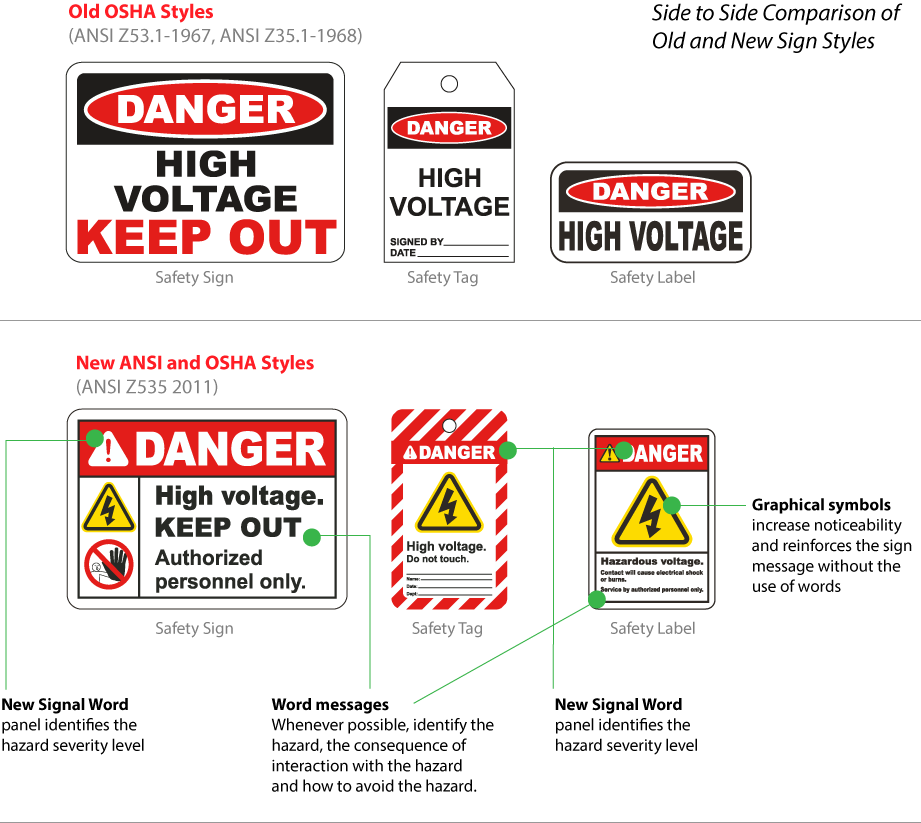OSHA Format
What is the OSHA format for safety signs?
Occupational Safety and Health Administration (OSHA) safety sign standards have gone through many changes, especially in the last few years. As OSHA sets and enforces safety standards, it is important to use compliant sign formats in the workplace.
OSHA first adopted the American National Standards Institute (ANSI) Z35.1-1968 standard in 1971 to define danger signs, caution signs, radiation warning signs, safety instruction signs, exit signs, directional signs, and informational signs.
This format includes a safety header or signal word such as “danger” to determine the risk level of the hazard, and a concise text legend that should make a positive suggestion that is easily understood.
In 2017, OSHA adopted the updated ANSI Z535-2011(R2017) standard, which defines layouts that more clearly and comprehensively identifies hazards and polices than previous layouts.
These updated layouts include a safety header like “danger” or “caution,” a text legend, and symbols or pictograms. This layout applies to signs, labels, and tags.
Depending on the industry, OSHA may have specific signage requirements that need to be met and do not specifically comply with ANSI Z535-2011. For example, in the OSHA 1910.1001 standard related to asbestos work areas, as of June 1, 2016 there is specific language that is required in a sign’s legend, and common designs do not use pictograms or symbols on these particular signs.
It is important to remember that even though OSHA has adopted updated sign layouts as part of its standards, both sign styles continue to be compliant with OSHA accident prevention signage standards.
What are ANSI standards?
ANSI is an independent organization that accredits standards for numerous industries. These standards help unify different ways to communicate information, such as accident prevention information. Learn more here.
What is the ANSI format for safety signs?
ANSI safety sign formats are based on the ANSI Z535-2011 standard. This standard has three important elements, including a safety header, images, and the sign legend. Learn more here.
Do I need OSHA or ANSI safety signs?
The goals of OSHA and ANSI designed signs are the same: to alert workers of potential hazards and of workplace polices. There are many factors that should be considered before choosing one design or the other, and in many cases, an ANSI formatted sign will comply with OSHA standards. Learn more here.
SafetySign.com does not recommend or specify the use of a specific safety sign because it does not have knowledge of the hazard(s) our customers are identifying. It is the customer’s sole responsibility to identify the hazard(s) that may be present and select one or more signs (stock or custom) that accurately identify their specific hazard(s) and complies with any applicable federal, state or local laws or regulations, any worksite specific rules or regulations and/or any applicable safety standards (including, without limitation, ANSI and/or OSHA standards). SafetySign.com disclaims any and all liability (excluding liability for our Product Warranty contained in our Terms and Conditions) for any sign selected by a customer and shall not be responsible for any personal injury or property damage resulting from the use of signs purchased from it or for the independent interpretation made of any applicable federal, state or local laws or regulations, any worksite specific rules or regulations, and/or any applicable safety standards (including, without limitation, ANSI and/or OSHA standards). Customer shall indemnify and hold SafetySign.com and its corporate parent and its officers, directors and affiliates harmless from and against any and all claims, loss or expense (including attorneys’ fees) arising from or related to the purchase and use by customer or any third party of any sign purchased by customer from SafetySign.com.

